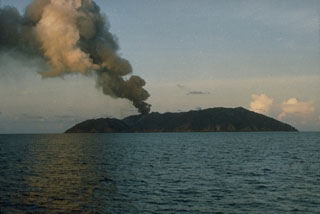Report on Barren Island (India) — July 2005
Bulletin of the Global Volcanism Network, vol. 30, no. 7 (July 2005)
Managing Editor: Edward Venzke.
Barren Island (India) Eruption continues; ash plumes seen in July and August
Please cite this report as:
Global Volcanism Program, 2005. Report on Barren Island (India) (Venzke, E., ed.). Bulletin of the Global Volcanism Network, 30:7. Smithsonian Institution. https://doi.org/10.5479/si.GVP.BGVN200507-260010
Barren Island
India
12.278°N, 93.858°E; summit elev. 354 m
All times are local (unless otherwise noted)
Heavy monsoon rains that fell soon after the beginning of the eruption on 28 May made observations and fieldwork difficult, and the eruption appeared to have ended by 6 July (BGVN 30:05). Based on information from the Indian Coast Guard, Dhanapati Haldar noted that as of 6 June the mode of eruption was Strombolian, the same as that observed during 1994-95, with fire fountains rising ~ 100 m, a dark plume rising 1 km, and lava piling up on the W face of the main cone.
On 13 June an Indian Navy ship transported Geological Survey of India scientists Sumit Kr. Mitra, P.C. Bandopadhyay, Sanjeev Raghav, and Tapan Pal to the island. Prior to the visit the volcano was spewing a gray ash plume charged with water vapor from both the main crater and a subsidiary vent on the SW slope. Around 13 June activity at the subsidiary vent decreased considerably and lava debris formed a mound of loose hot fragments. Forceful ejection of bombs and lapilli continued from the main crater. The proximal accumulations of pyroclasts displayed some incandescence. Red-hot lava fragments were forcefully ejecting from the main crater to heights of more than 100 m, accompanied by loud explosions. Strombolian fire fountains every 15-30 seconds created an eruption column and mushroom-shaped plume that blew to the N. Hand specimen study revealed both jet-black and brownish black basaltic fragments. Both types contained large phenocrysts of plagioclase and pyroxene in a finer black groundmass with a porphyritic texture.
A story in the BBC News-World Edition of 11 July about the volcano becoming a tourist attraction served by charter boats included a statement that lava was flowing into the sea. However, the observation was not dated or attributed to a specific source.
According to a pilot's report described in a Volcanic Ash Advisory, ash was visible near Barren Island on 18 July at 0211 at an altitude of ~ 6.1 km. Ash was observed on satellite imagery at 0755 that day below 4.6 km altitude. MODIS imagery from the NASA Terra satellite at 0930 (0400 UTC) showed a distinct brown plume extending around 4.6 km NNE. A plume was again reported by a pilot on 18 August at an altitude of ~ 3 km, although ash was not visible on satellite imagery.
Geological Summary. Barren Island, a possession of India in the Andaman Sea about 135 km NE of Port Blair in the Andaman Islands, is the only historically active volcano along the N-S volcanic arc extending between Sumatra and Burma (Myanmar). It is the emergent summit of a volcano that rises from a depth of about 2250 m. The small, uninhabited 3-km-wide island contains a roughly 2-km-wide caldera with walls 250-350 m high. The caldera, which is open to the sea on the west, was created during a major explosive eruption in the late Pleistocene that produced pyroclastic-flow and -surge deposits. Historical eruptions have changed the morphology of the pyroclastic cone in the center of the caldera, and lava flows that fill much of the caldera floor have reached the sea along the western coast.
Information Contacts: Geological Survey of India, 27 Jawaharlal Nehru road, Kolkata 700016, India (URL: http://www.gsi.gov.in/); Dhanapati Haldar, Presidency College, Kolkata, India; Jenifer E. Piatt, U.S. Air Force Weather Agency (AFWA), Satellite Applications Branch, Offutt Air Force Base, Nebraska 68113, USA (URL: http://www.557weatherwing.af.mil/); Darwin Volcanic Ash Advisory Centre (VAAC), Bureau of Meteorology, Northern Territory Regional Office, PO Box 40050, Casuarina, Northern Territory 0811, Australia (URL: http://www.bom.gov.au/info/vaac/); BBC News World Edition, Room 7540, BBC Television Centre, Wood Lane, London W12 7RJ, United Kingdom (URL: http://news.bbc.co.uk/).

